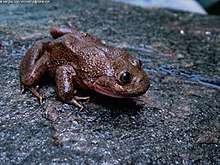Telmatobius
| Telmatobius | |
|---|---|
 | |
| Telmatobius species from altiplano lakes in northern Chile. | |
| Scientific classification | |
| Kingdom: | Animalia |
| Phylum: | Chordata |
| Class: | Amphibia |
| Order: | Anura |
| Family: | Telmatobiidae Fitzinger, 1843 |
| Genus: | Telmatobius Wiegmann, 1834 |
| Diversity | |
| 64 species (see text) | |
| Synonyms | |
|
Batrachophrynus Peters, 1873 | |
Telmatobius is a genus of frogs native to the Andean highlands in South America, where they are found in Ecuador, Peru, Bolivia, northwestern Argentina and northern Chile.[1] It is the only genus in the family Telmatobiidae.[2] Some sources recognize Batrachophrynus as a valid genus distinct from Telmatobius.[3][4]
Ecology and conservation
All Telmatobius species are closely associated with water and most species are semi-aquatic, while a few are entirely aquatic.[5] They are found in and near lakes, rivers and wetlands in the Andean highlands at altitudes between 1,000 and 5,200 m (3,300–17,100 ft).[6] The genus includes two of the world's largest fully aquatic frogs, the Lake Junin frog (T. macrostomus) and Titicaca water frog (T. culeus),[7] but the remaining are considerably smaller. Telmatobius contains more than 60 species; the vast majority seriously threatened, especially from habitat loss, pollution, diseases (chytridiomycosis and nematode infections), introduced trout, and capture for human consumption.[5][8] The three Ecuadorian species have not been seen for years and may already be extinct: T. cirrhacelis last seen in 1981, T. niger in 1994 and T. vellardi in 1987.[5][8]
Species
There are currently 64 recognized Telmatobius species,[1] but the validity of some species is questionable and it is likely that undescribed species remain.[9][10]
- Telmatobius arequipensis Vellard, 1955
- Telmatobius atacamensis Gallardo, 1962
- Telmatobius atahualpai Wiens, 1993
- Telmatobius bolivianus Parker, 1940
- Telmatobius brachydactylus (Peters, 1873)
- Telmatobius brevipes Vellard, 1951
- Telmatobius brevirostris Vellard, 1955
- Telmatobius carrillae Morales, 1988
- Telmatobius ceiorum Laurent, 1970
- Telmatobius chusmisensis Formas, Cuevas, and Nuñez, 2006
- Telmatobius cirrhacelis Trueb, 1979
- Telmatobius colanensis Wiens, 1993
- Telmatobius contrerasi Cei, 1977
- Telmatobius culeus (Garman, 1876)
- Telmatobius dankoi Formas et al., 1999
- Telmatobius degener Wiens, 1993
- Telmatobius edaphonastes De la Riva, 1995
- Telmatobius espadai De la Riva, 2005
- Telmatobius fronteriensis Benavides, Ortiz, and Formas, 2002
- Telmatobius gigas Vellard, 1969
- Telmatobius halli Noble, 1938
- Telmatobius hauthali Koslowsky, 1895
- Telmatobius hintoni Parker, 1940
- Telmatobius hockingi Salas and Sinsch, 1996
- Telmatobius huayra Lavilla and Ergueta-Sandoval, 1995
- Telmatobius hypselocephalus Lavilla and Laurent, 1989
- Telmatobius ignavus Barbour and Noble, 1920
- Telmatobius intermedius Vellard, 1951
- Telmatobius jelskii (Peters, 1873)
- Telmatobius laevis Philippi, 1902
- Telmatobius laticeps Laurent, 1977
- Telmatobius latirostris Vellard, 1951
- Telmatobius macrostomus (Peters, 1873)
- Telmatobius mantaro Ttito et al., 2016
- Telmatobius marmoratus (Duméril and Bibron, 1841)
- Telmatobius mayoloi Salas and Sinsch, 1996
- Telmatobius mendelsoni De la Riva, Trueb, and Duellman, 2012
- Telmatobius necopinus Wiens, 1993
- Telmatobius niger Barbour and Noble, 1920
- Telmatobius oxycephalus Vellard, 1946
- Telmatobius pefauri Veloso and Trueb, 1976
- Telmatobius peruvianus Wiegmann, 1834
- Telmatobius philippii Cuevas and Formas, 2002
- Telmatobius pinguiculus Lavilla and Laurent, 1989
- Telmatobius pisanoi Laurent, 1977
- Telmatobius platycephalus Lavilla and Laurent, 1989
- Telmatobius punctatus Vellard, 1955
- Telmatobius rimac Schmidt, 1954
- Telmatobius rubigo Barrionuevo and Baldo, 2009
- Telmatobius sanborni Schmidt, 1954
- Telmatobius schreiteri Vellard, 1946
- Telmatobius scrocchii Laurent and Lavilla, 1986
- Telmatobius sibiricus De la Riva and Harvey, 2003
- Telmatobius simonsi Parker, 1940
- Telmatobius stephani Laurent, 1973
- Telmatobius thompsoni Wiens, 1993
- Telmatobius timens De la Riva, Aparicio, and Ríos, 2005
- Telmatobius truebae Wiens, 1993
- Telmatobius vellardi Munsterman and Leviton, 1959
- Telmatobius ventriflavum Catenazzi, Vargas García, and Lehr, 2015
- Telmatobius verrucosus Werner, 1899
- Telmatobius vilamensis Formas, Benavides, and Cuevas, 2003
- Telmatobius yuracare De la Riva, 1994
- Telmatobius zapahuirensis Veloso et al., 1982
References
- 1 2 Frost, Darrel R. (2017). "Telmatobius Wiegmann, 1834". Amphibian Species of the World: an Online Reference. Version 6.0. American Museum of Natural History. Retrieved 9 February 2017.
- ↑ Frost, Darrel R. (2015). "Telmatobiidae Fitzinger, 1843". Amphibian Species of the World: an Online Reference. Version 6.0. American Museum of Natural History. Retrieved 23 May 2015.
- ↑ Blackburn, D.C.; Wake, D.B. (2011). "Class Amphibia Gray, 1825. In: Zhang, Z.-Q. (Ed.) Animal biodiversity: An outline of higher-level classification and survey of taxonomic richness" (PDF). Zootaxa. 3148: 39–55.
- ↑ "Telmatobiidae". AmphibiaWeb: Information on amphibian biology and conservation. [web application]. Berkeley, California: AmphibiaWeb. 2015. Retrieved 23 May 2015.
- 1 2 3 Angulo, A. (2008). Conservation Needs of Batrachophrynus and Telmatobius Frogs of the Andes of Peru. Conservation & Society 6(4): 328-333. DOI: 10.4103/0972-4923.49196
- ↑ Victoriano, Muñoz-Mendoza, Sáez, Salinas, Muñoz-Ramírez, Sallaberry, Fibla and Méndez (2015). Evolution and Conservation on Top of the World: Phylogeography of the Marbled Water Frog (Telmatobius marmoratus Species Complex; Anura, Telmatobiidae) in Protected Areas of Chile. J.Hered. 106 (S1): 546-559. DOI: 10.1093/jhered/esv039
- ↑ Halliday, T. (2016). The Book of Frogs: A Life-Size Guide to Six Hundred Species from around the World. University Of Chicago Press. ISBN 978-0226184654
- 1 2 Stuart, Hoffmann, Chanson, Cox, Berridge, Ramani and Young, editors (2008). Threatened Amphibians of the World. ISBN 978-84-96553-41-5
- ↑ De la Riva (2005). Bolivian frogs of the genus Telmatobius: synopsis, taxonomic comments, and description of a new species. Monogr. Herpetol. 7:65-101.
- ↑ Sáez, Fibla, Correa, Sallaberry, Salinas, Veloso, Mella, Iturra, and Méndez (2014). A new endemic lineage of the Andean frog genus Telmatobius (Anura, Telmatobiidae) from the western slopes of the central Andes. Zoological Journal of the Linnean Society 171: 769–782.
External links
| Wikispecies has information related to Telmatobius |